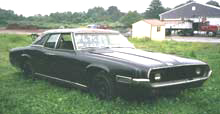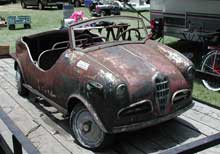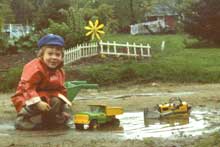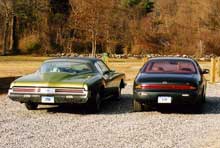Days of Thunder
Ford's Thunderbird cannot claim the longest consecutive run of a model name, but it can certainly make a case for the most adventurous search of identity over nearly half a century. What began as a two-seat sports roadster in the 1955 model year ended as a "personal luxury" coupe 44 years later, then after a five-year hiatus returned to its roots.
Actually, Ford never called the Thunderbird a sports car, unlike Chevy with the T-Bird's competition, the Corvette. The Thunderbird's adjective was always "personal." "Luxury" was added later, when the 'Bird gained seats for four and moved upmarket. Some decried the baroque "Squarebirds" of 1958-60, but the customers didn't. Sales of the 1958 model were more than double those of 1956. For 1961, Thunderbird moved into its "Cigarbird" phase, with a pleasingly pointed design originally intended for front-wheel drive. Fwd was ditched as too costly, left for GM to pioneer with the Olds Toronado in 1966 (and it is said The General licensed the powertrain design from Ford). A novel feature of the '61 was a "swing away" steering wheel. Thunderbird's body was squared up again in 1964; in 1966 the last convertible was built.
A new design for 1967 brought two wheelbases, 114.7 inches for the coupe (this is a '68) and 117.2 for a (gasp) sedan with "suicide" rear doors. The latter was used as a platform for the Lincoln Continental Mk III two years later. (The Thunderbird Landau Sedan is not the most out-of-character car built by Ford Motor Company. Consider the Mercury Cougar Villager station wagon of 1977.) By 1972, the "Bird" had retreated to its coupe persona and become a sibling of the Continental Mk IV.
But the big 'Birds were heavy and thirsty, so for 1977 came a downsized car. Half a ton lighter and nearly $3000 cheaper than its predecessor, its sales grew sixfold. For 1980, it was downsized yet again, on the Fox platform (Fairmont/Zephyr). By 1981, it even came with a six-cylinder engine, Ford's 200 cid Mustang/Maverick/Granada unit. (Although the six was mentioned in sales literature, only the V8 was illustrated.)
In 1983, Thunderbird gained back its unique personality with a new coupe of softened contours, and engine options including a turbocharged four. In 1989 came the final iteration of the Thunderbird coupe, initially with only V6 power, though a 210-hp "Super Coupe" was supercharged. In 1991 the familiar 5.0-liter V8 returned, replaced in 1994 by the new "modular" ohc 4.6-liter unit. Sleeker than the 1983-89 'Bird, this new coupe continued with few changes until the plug was pulled after the 1997 model year.
Rumors of a new coupe, possibly front-drive, abounded, but a retro concept at the 1999 Detroit auto show hinted the new direction. A "modern heritage" style, in Ford's words, it was clearly cued from the 1955-57 two-seaters. It went into production as a 2002 model, but sales were underwhelming. Perhaps merely an inspirational exercise, like the Plymouth Prowler, the new T-Bird ended with a 50th Anniversary model, the last of which rolled out on July 1, 2005. What would have happened had the two-seater been brought back earlier? Well it might have been. Around 1960 a downsized roadster, not unlike the 2002 car, was built. Powered by a supercharged Falcon six, the car survives in the collection of The Henry Ford.
I've never owned a T-Bird, but I do have preferences. Of the two-seaters, my favorite is the '57. Squarebirds and the downsized 1977-82s hold no attraction for me, but a '63 Cigarbird could catch my fancy. As an automotive contrarian, though, I might just go for a Landau Sedan.





